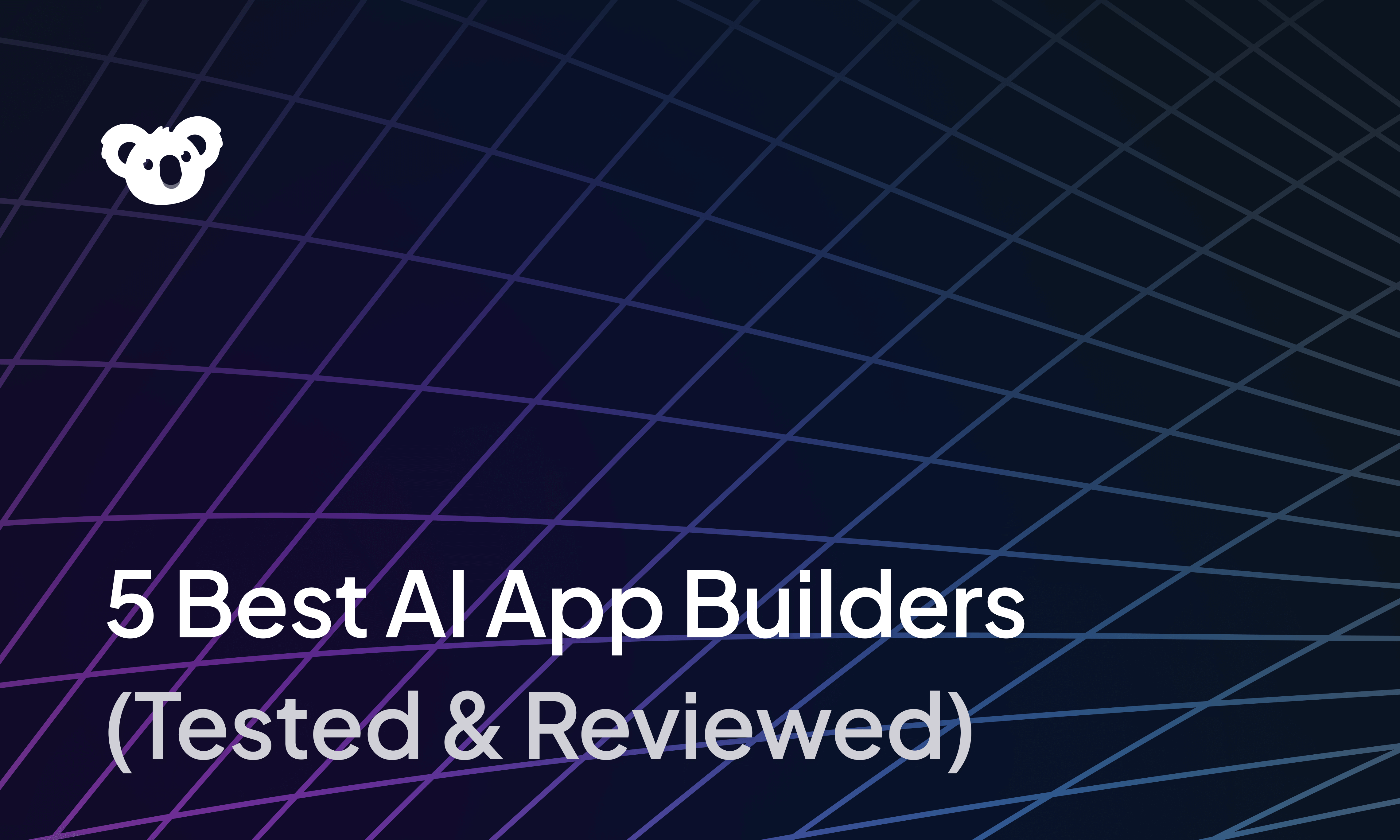


Mendix was named a leader in Gartner’s 2024 Magic Quadrant for enterprise low-code, but how well does that reputation hold up in practice? Users praise its speed and enterprise-grade governance features, but also call out a steep learning curve, limited UI customization, and high pricing.
In this article, we’ll cover:
- What Mendix is used for
- Pros and cons from real user reviews
- A side-by-side look at Mendix vs. Superblocks
Let’s start by discussing Mendix and its core features.
What is Mendix?

Mendix is a platform for building web and mobile applications with visual tools and minimal hand-coding. It provides an all-in-one environment for designing, building, deploying, and maintaining apps at scale.
Most teams use Mendix to create internal tools, customer portals, or modern replacements for legacy systems. It’s especially popular with large enterprises that need both speed and governance. IT can maintain control, while business users can collaborate more closely in app development.
Compared to from-scratch coding, Mendix delivers a significant productivity boost. It also offers more flexibility than pure no-code tools, since developers can extend Mendix apps with custom Java and JavaScript when needed.
Mendix features
Here are some of the core features teams rely on:
- Drag-and-drop UI builder: Mendix offers a visual page editor and pre-built UI components (via its Atlas UI framework) to help teams build UIs for web and mobile apps without writing HTML or CSS.
- Built-in DevOps tools: The platform includes built-in tools for version control, collaboration, and DevOps. Teams can manage user stories, track feedback, and collaborate in real-time within Mendix.
- Mobile + web deployment: Mendix supports multi-channel deployment out of the box. Teams can deliver responsive web apps, progressive web apps, and native mobile apps from a single project.
- Cloud and on-prem deployments: Mendix apps run on a proprietary runtime you can deploy to Mendix Cloud, your own cloud, or on-prem infrastructure.
- Marketplace for components: Mendix provides a marketplace of reusable components, templates, and connectors. While quality varies, this can help teams accelerate common integrations and UI patterns.
- Governance & security: The platform supports enterprise-grade access control and governance. You can define user roles, permissions, and ensure compliance rules within the Mendix app. It also offers auditing, activity logs, and quality checks.
Mendix pros (According to real users)
Here’s what real users highlight as Mendix’s biggest strengths, based on recent reviews and community feedback on G2, Gartner Peer Insights, and developer forums like Reddit:
- Faster development: Teams frequently cite fast turnaround times from concept to deployment in just weeks.
- Ease of use & accessibility: Mendix earns praise for being approachable to a wide range of users. Non-technical users can contribute to app development through visual tools, while developers can extend apps with code as needed.
- Enterprise-ready features: The platform stays online during outages by running across multiple servers. It fails over automatically and balances traffic under load. Built-in controls let teams manage access, track changes, and enforce policies.
- Integration and extensibility: Users consistently note that integrating Mendix apps with REST, SOAP, OData, and direct databases is straightforward. The ability to add custom Java and JavaScript where needed is also seen as a key advantage.
- Complete lifecycle & DevOps in one platform: Teams appreciate that Mendix supports the full app lifecycle, from design and testing to deployment and maintenance. It also has built-in version control and supports CI/CD integrations.
- Business-IT collaboration: Mendix supports visual modeling so business teams can review features and stay involved throughout the development process.
Mendix cons (What users complain about)
Despite its many advantages, Mendix is not without pain points. Users have been candid about several challenges and drawbacks:
- Steeper learning curve for complex development: Experienced users caution that building serious applications is not as “anyone can do it” as marketing might imply. Mendix’s own community often recommends hiring or training Mendix experts.
- Performance and complexity at scale: Some users report slow performance as applications grow in complexity due to large datasets, heavy logic, or high user traffic.
- Limited UI customization: The Atlas UI framework is solid for standard enterprise designs, but implementing fine-grained or highly bespoke UIs can be challenging.
- High pricing and licensing frustrations: Mendix offers a free tier for building and prototyping, but production use gets expensive fast. The Standard plan starts at $998/month for one app, which limits flexibility for growing teams.
- Vendor lock-in: Perhaps the biggest strategic concern echoed by multiple users is platform lock-in. Mendix apps rely on proprietary models, workflows, and runtime. Migrating to another stack often means rebuilding the app from scratch.
- Talent and hiring: An interesting theme is the availability of Mendix developers. Organizations sometimes struggle to hire experienced Mendix devs since it’s a niche skillset compared to, say, JavaScript or .NET. Companies often either outsource to Mendix partners or take good traditional developers and cross-train them in Mendix.
Mendix vs. Superblocks: How do they stack up?
Mendix prioritizes accessibility for business users and collaboration within the organization. Superblocks offers more development flexibility with support for AI app-gen, low-code, and full-code customization.
Here’s a side-by-side look at how they differ across key dimensions:
Key differences:
- Flexibility for technical and non-technical teams: Superblocks offers an AI agent called Clark that lets you generate apps from natural language prompts with full awareness of your design systems and permissioning structures. You refine these apps visually or raw code as needed.
- UI customization: Superblocks allows full React customization. You can bring in fully bespoke components to use within the platform.
- Portability: Mendix locks apps into its proprietary runtime, which makes migration difficult. Moving to another stack usually requires a full rebuild. Superblocks is API-first and designed to integrate with your existing infrastructure, with no runtime lock-in. Apps and workflows can be easily adjusted or migrated if your stack evolves.
- Deployment model: Superblocks runs as a lightweight service that connects to your APIs and infrastructure, with an optional on-prem agent. Mendix apps are deployed on its proprietary runtime, either in Mendix Cloud or on-prem, but apps remain tightly coupled to the Mendix stack.
- Developer experience: Superblocks is designed for developers who want to “own their stack” while getting the benefits of faster app development. Mendix caters to mixed teams of business users and developers, prioritizing accessibility and governance over raw flexibility.
Final thoughts: Is Mendix still the best low-code platform?
Mendix is a solid choice for enterprise teams that need strong governance, built-in scalability, and support for business–IT collaboration. It delivers an all-in-one platform with the controls large organizations rely on.
That said, for teams that prioritize flexibility and developer control, Superblocks is a compelling alternative. It offers centralized governance, audit logs, RBAC, and hybrid deployment options, plus full-code customization and no lock-in.
When you’re evaluating whether Mendix is for you, the key question is this: What kind of team do you have, and how much do you want to own your app delivery stack? If your developers want full control and portability, Superblocks is the better fit.
Try Superblocks for flexible, enterprise-grade app development
Superblocks gives enterprise teams full control without locking them into a closed stack. You can write real code, connect to any system, and deploy on your terms. This allows you to enforce the same governance standards used across your org.
This is possible thanks to our comprehensive set of features:
- Multiple ways to build: Start with Clark AI to generate apps in plain English, fine-tune them in the visual editor, and drop into full React code when needed — all within a unified workflow.
- Full-code extensibility: Build with JavaScript, Python, SQL, and React, connect to Git, and deploy with your existing CI/CD pipeline.
- Integration with your existing systems: Work with your existing stack — databases, SaaS tools, warehouses, and any system with an API.
- Built-in integrations with popular AI models: Integrate OpenAI, Anthropic, and others to power AI workflows and assistants.
- Centralized governance: Enforce RBAC, authentication, and security policies from a single control plane.
- Standardized UI components: Build consistent apps using reusable elements aligned with your design system.
- Full portability: Export your app as raw React code and run it independently.
- Centralized audit logs: Every edit, run, and update is tracked in centralized logs for compliance and oversight.
- Fits into existing SDLCs & DevOps pipelines: Supports automated testing, CI/CD integration, version control (Git), and staged deployments so you can manage changes.
- Incredibly simple observability: Receive metrics, traces, and logs from all your internal tools directly in Datadog, New Relic, Splunk, or any other observability platform.
If you’d like to see these features in practice, take a look at our Quickstart Guide, or better yet, try Superblocks for free.
Frequently asked questions
What is Mendix used for?
Mendix is primarily used to build enterprise-grade applications such as internal tools, customer portals, and modern replacements for legacy systems.
How does Mendix pricing compare to Superblocks?
Mendix uses a mix of per-app and per-user fees, starting at $998/month for a single app. Final pricing depends on your deployment model, number of users, and the number of apps you build. Superblocks offers quote-based pricing tailored to your organization’s needs. It is based on the number of creators, internal users, external users, and deployment model.
Is Superblocks a better alternative to Mendix?
If you want a more open, API-first, and flexible platform while still meeting enterprise requirements, Superblocks is a better alternative to Mendix.
What are Mendix’s biggest limitations?
Common limitations include a steep learning curve, performance challenges at scale, limited UI flexibility, a closed platform architecture, and high costs as usage grows.
Is Mendix a no-code or low-code platform?
Mendix offers both a no-code experience for business users (via Mendix Studio) and a low-code experience for professional developers (via Mendix Studio Pro).
What’s the learning curve for Mendix?
Building complex, high-performance apps requires significant expertise. Many teams invest in training or hire Mendix specialists to handle advanced use cases.
Can Mendix handle microservices and API integrations?
Yes. Mendix supports integration with REST, SOAP, and OData services and can connect to external data sources through connectors or integrations. It also allows you to expose Mendix functionality as APIs.
What are the best Mendix alternatives for developers?
For teams that want to avoid lock-in and prefer a platform that is easy to use with flexible development options, Superblocks is the best option. If you're looking for a fully open-source Mendix alternative, consider Budibase or Appsmith.
Is Mendix worth it for small or mid-sized teams?
For smaller teams, Mendix’s cost and complexity may be overkill.
What’s the difference between Mendix and OutSystems?
Mendix and OutSystems are both enterprise low-code platforms with similar strengths and tradeoffs. Both offer web and mobile support, strong governance, closed architectures, and high costs at scale. OutSystems is generally more expensive than Mendix, starting at $36,300/year. It uses .NET (or Java) for custom code, while Mendix is built on a Java-based stack.
Stay tuned for updates
Get the latest Superblocks news and internal tooling market insights.
You've successfully signed up
Request early access
Step 1 of 2
Request early access
Step 2 of 2
You’ve been added to the waitlist!
Book a demo to skip the waitlist
Thank you for your interest!
A member of our team will be in touch soon to schedule a demo.
Table of Contents



.png)


